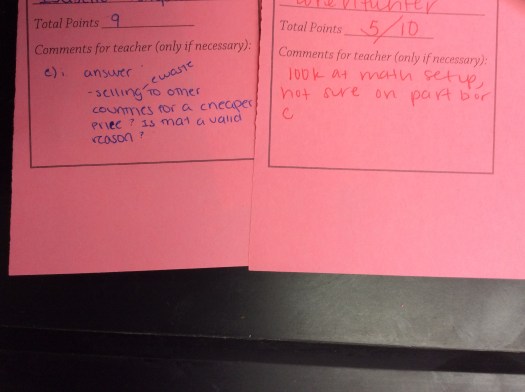Peer Grading FRQS
Peer grading free response questions is a great way to
1. Teach kids how the questions are graded by the national readers and how picky and precise the language should be.
2. Save you some personal time.
My method of peer grading has morphed into this method through the years. Like most teachers I’ve take ideas of here and there and merged into what works for me. You can read how I use and teach FRQs here.
When we peer grade, my students write their student ID # on the FRQ instead of their name. A couple of days after the exam (when most make-ups are finished), I pass out the FRQs to grade. Since I teach multiple sections of AP, classes don’t grade their own class’ FRQs. That way, its harder for the students to know if they’re grading someone that they know. I also pass out a pink slip.

I don’t usually use the College Board rubrics for peer grading with the students. Many students find them confusing. Instead, I type the most common answers from the rubric that I know my students will use on a PowerPoint. If you are new to teaching the course, I suggest you place the answers that your students learned in the textbook, activities, or lecture. Its unlikely that students will know or guess something different (but it does happen so be sure to answer questions). We go through each part of the FRQ on the PowerPoint and I answer any questions. The only exception to is when we grade math.

Students need to highlight the exact words that give the points. This helps students understand that they don’t need to write lots of words and sentences for points and helps them clearly identify where the points are. They are not guessing or saying “well it sounds right” and give points. They need to clearly indicate where the points are by highlighting.

When we grade math, I find it best to copy just the page with the math solutions from the College Board rubrics. That way, kids can see exactly what their math needs to look like. I also make notes on the rubric about remembering units and how any points each question is worth. After the math is graded, we go back to a PowerPoint for the rest of the FRQ.

After all sections are graded, students add up the points out of 10 or 11 and write on the top of the students’ paper. They also write it on the pink slip. If they need me to check something or they had another comment for me only, they need to write it on the pink slip. Students will never get the pink slips back to them. They are only for me. This helps with anonymity.


I go through each pink slip and check for comments. When I’m finished, I recycle/toss the pink slips.
Students will get their own FRQ returned to them to check over on a different day. I also include a “fudge” point in the curve. If they want to argue 1 point, I say I don’t want to hear it as its factored in the curve. If they find 2 or more points in error, they can come see me, but they have to show me exactly where the mistake was made. They cannot say “I’m sure I got more points, can you please check it over?” This prevents a long line of students who want to argue one point or grasping at straws to get a better grade.
Here’s my peer-graded curve as an FRQ is worth 50 exam points for me. (Multiple Choice is worth 100 points)
10=50
9=50
8=48
7=45
6=42
5=40
4=36
3=31
2=25
1=15


4 thoughts on “FRQs and Peer Grading”